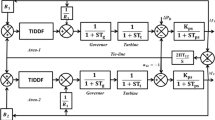Abstract
This article highlights the modeling and simulation of a pragmatic isolated power system consisting of a combined cycle gas turbine (CCGT) plant and a dish-Stirling solar thermal (DSTS) plant for the combined frequency and voltage control system. The system is provided with the adequate generation rate constraint of 5%/minute and the boiler system as non-linearities for a more realistic study. For the secondary, airflow, temperature, and AVR loop controller, the fractional-order proportional integral derivative (PIλDμ) controller is proposed, and the output of the same is evaluated by comparing with other integer-order controllers. The gains from the controller and other parameters are optimized concurrently using the black widow optimization (BWO) algorithm. The analysis of responses reveals that the PIλDμ controller is preeminent than the other classical controllers. The influence of the DSTS plant on the isolated system is investigated and shows that the incorporation of the DSTS plant contributes to improved system dynamics in terms of the time-domain indices. Analyzing the consequences of non-linearities of the system reveal that responses have continually oscillated. Simulation results corroborate the efficiency of the suggested control technique.
Access this chapter
Tax calculation will be finalised at checkout
Purchases are for personal use only
Similar content being viewed by others
References
Elgerd, O.I.: Electric Energy Systems Theory—An Introduction, 2nd edn. Tata McGraw-Hill, New Delhi, India (2000)
Kundur, P.: Power System Stability and Control. Tata McGraw-Hill, New York, NY, USA (1994)
Bevrani, Hassan: Robust Power System Frequency Control, vol. 85. Springer, New York (2009)
Elgerd, O.I., Fosha, C.E.: Optimum megawatt-frequency control of multiarea electric energy systems. IEEE Trans. Power Apparatus Syst. PAS 89(4), 556–563 (1970)
Nanda, J., Mishra, S., Saikia, L.C.: Maiden application of bacterial foraging-based optimization technique in multiarea automatic generation control. IEEE Trans. Power Syst. 24(2), 602–609 (2009)
Lalor, G., Ritchie, J., Flynn, D., O’Malley, M.J.: The impact of combined-cycle gas turbine short-term dynamics on frequency control. IEEE Trans. Power Syst. 20(3), 1456–1464 (2005)
Saikia, L.C., Sahu, S.K.: Automatic generation control of a combined cycle gas turbine plant with classical controllers using the firefly algorithm. Int. J. Electr. Power Energy Syst. 53, 27–33 (2013)
Hasan, N., Rai, J.N., Arora, B.B.: Optimization of a CCGT power plant and performance analysis using MATLAB/Simulink with actual operational data. Springer Plus 3(1), 275 (2014)
Saha, D., Saikia, L.C.: Automatic generation control of a multi-area CCGT-thermal power system using stochastic search optimized integral minus proportional derivative controller under restructured environment. IET Gener. Transm. Distrib. 11(15), 3801–3813 (2017)
Gözde, H., Taplamacioglu, M.: Comparative performance analysis of artificial bee colony algorithm for automatic voltage regulator (AVR) system. J. Franklin Inst. Eng. Appl. Math. 348, 1927–1946 (2011)
Panda, S., Sahu, B.K., Mohanty, P.K.: Design and performance analysis of PID controller for an automatic voltage regulator system using simplified particle swarm optimization. J. Franklin Inst. 349(8), 2609–2625 (2012)
Rakhshani, E., Rouzbehi, K., Sadeh, S.: A new combined model for simulation of mutual effects between LFC and AVR loops. In: Asia-Pacific Power and Energy Engineering Conference, pp. 1–5, Wuhan (2009)
Rajbongshi, R., Saikia, L.C.: Combined control of voltage and frequency of multi-area multisource system incorporating solar thermal power plant using LSA optimized classical controllers. IET Gener. Transm. Distrib 11(10), 2489–2498 (2017)
Rajbongshi, R., Saikia, L.C.: Combined voltage and frequency control of a multi-area multisource system incorporating dish-Stirling solar thermal and HVDC link. IET Gener. Transm. Distrib 12(3), 323–334 (2018)
Li, Y., Choi, S.S., Yang, C.: Dish-stirling solar power plants: modeling, analysis, and control of receiver temperature. IEEE Trans. Sustain. Energy 5(2), 398–407 (2014)
Podlubny, I.: Fractional-order systems and PIλDμ-controllers. IEEE Trans. Autom. Control 44(1), 208–214 (1999)
Hayyolalam, V., Kazem, A.A.P.: Black widow optimization algorithm: a novel meta-heuristic approach for solving engineering optimization problems. Eng. Appl. Artif. Intell. 87(2020), 103249, ISSN 0952-1976 (2020)
Jagatheesan, K., Anand, B.: Load frequency control of an interconnected three area reheat thermal power systems considering non-linearity and boiler dynamics with a conventional controller. Adv. Nat. Appl. Sci. 8(20), 16–25 (2014)
Author information
Authors and Affiliations
Corresponding author
Editor information
Editors and Affiliations
Appendix
Appendix
Ambient temperature, Ti = 300 ℃, compressor discharge temperature, Td = 3900 ℃, gas turbine exhaust temperature, Te = 5460 ℃, specific ratio of heat = 1.4, efficiency of compressor = 0.85, time constant for governor, Tg = 0.08 s, turbine time constant, Tt = 0.3 s, thermocouple time constant, Tth = 2.5 s, Ka = 0.8, Kb = 0.2, time constant of valve position, Tv = 0.1 s, time constant of fuel, Tf = 0.4 s, time constant of compressor volume, Tcd = 0.2 s, tune metal heat capacitance, Tm = 5 s, time constant of IGV, Tigv = 0.05 s, inertia constant, inertia constant = 5 s, D = 0.00833 pu MW/Hz, frequency bias = 0.425 pu MW/Hz, R = 2.4 pu Hz/MW, KPi = 120 Hz/puMW, Tpi = 20 s, KDSTS = 1, TDSTS = 5 s. K1 = 1, K2 = −0.1, K3 = 0.5, K4 = 1.4, K5 = 0.1455, K6 = 0.35.
Genetic algorithm (GA): population count = 45, iteration max count = 120, ratio = 0.8, mutation ratio = 0.3, particles swarm optimization (PSO): population count = 45, iteration max count = 100, firefly algorithm (FA): iteration count = 100, population count = 50, α = 0.5, β = 0.2, γ = 0.5.
Rights and permissions
Copyright information
© 2021 The Author(s), under exclusive license to Springer Nature Singapore Pte Ltd.
About this paper
Cite this paper
Ramoji, S.K., Saikia, L.C., Dekaraja, B., Babu, N.R., Bhagat, S.K., Behera, M.K. (2021). Modeling and Simulation of an Isolated CCGT and DSTS Plant Using BWO Optimized PIλDμ Controller for Amalgamated Control of Voltage and Frequency. In: Das, B., Patgiri, R., Bandyopadhyay, S., Balas, V.E. (eds) Modeling, Simulation and Optimization. Smart Innovation, Systems and Technologies, vol 206. Springer, Singapore. https://doi.org/10.1007/978-981-15-9829-6_23
Download citation
DOI: https://doi.org/10.1007/978-981-15-9829-6_23
Published:
Publisher Name: Springer, Singapore
Print ISBN: 978-981-15-9828-9
Online ISBN: 978-981-15-9829-6
eBook Packages: Intelligent Technologies and RoboticsIntelligent Technologies and Robotics (R0)




